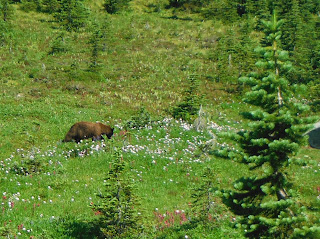 |
| Panoramic from atop Coldwater Peak |
Coldwater Peak, just five miles from the summit of Mt. St. Helens, offers an austere beauty, and on a perfect blue sky day, vistas of five volcanoes including Mt. Rainier, Mt. Adams, Mt. Hood, and of course, Mt. St. Helens. The other popular hike nearby, Harry's Ridge offers a similar perspective, but Rainier in hidden behind the higher peak. Without climbing up Coldwater Peak, you will miss out on Rainier.
 |
| Hiking through the blast zone |
My best friend, Russ and I left Snohomish County around 5 AM. Around 9 AM we reach the parking lot at Johnston Observatory. The visitors' center, where the restrooms are located, doesn't open until 10. We found a ranger who told us that day permits were required for the trail, but we could check in after the hike.
 |
| Russ works his way down the trail |
The trail moves north through the bast zone, on a ridge above a valley carved my snow-fed rivers and wind. For us, the trail was hot and dry, but not overly dusty. Really, there is no shade along the way. By walking the devastated landscape, we were amazed by the scale of the scene. Recovery has been slow. The blast occurred in 1980, and still, the vegetation is a fraction of Rainier. However, blue huckleberries were abundant along the trail.
In the hole in the wall, just before the main hill, the rock affords some shadow, but wear a big brimmed hat, and carry SPF 50 sunblock. I froze a Nalgene bottle that slowly thawed in the heat. It was great to drink icy water on our breaks along the way.
 |
| Locally known as the Arches--really, a hole in the wall |
The hike plays much more difficult than the overview would suggest. About 2000 feet in less than six miles sounds moderate for committed hikers in late summer. HOWEVER, the trail begins by going down then up, then down, then up. Essentially, you make a three mile approach before you work up a Mt. Pilchuck-like climb.
The trail begins open and wide, and offers easy miles 2/3rd of the way. However, once you are on the main hill, above Coldwater Lake, the trail is steep and narrow, brushy, and a little treacherous in a couple of places.
 |
| Seismic Equipment Pointed at the Crater |
The seismic equipment facing the great crater creates a Sci-Fi vibe as you reach the summit. Melted glass is evident at the sight of an old lookout. Strangely enough, black flying ants were swarming in the afternoon sun at the very peak of the mountain. They didn't bite, but they weren't great lunch companions. We moved down from the top a bit to enjoy our sandwiches. Two ravens and a small hawk soared in the thermals.
 |
| Spirit Lake where Harry Truman made his last stand. |
Mt. St. Helens draws folks from all over the country and the world which enriches the hiking experience. A Swiss mother and her two teenage sons arrived at the summit before us. A graduate student in Volcanology from Vermont and her mom, came up later. We met families from Canada and as well as Iowa. Two educators from Oregon were enjoying the last days of summer vacation. On the way down, we looked back up the hill and saw a strong mountain goat watch our retreat.
 |
| A solitary mountain goat |
In the afternoon sun, the undulations with the final up to the trailhead seemed a little gratuitous. We finished at the observation trail above the visitors' center. It's worth the few hundred yards of extra work just to see the memorial to those who lost their lives on the mountain including Harry Truman and David Johnston.
At the ranger station, we checked in, so that our numbers counted towards the total visitors. The bathrooms were open. We spent some time looking at the displays. Looking at the models, photographs and video of the eruption made the hike even more meaningful. Despite the heat and austerity of the hike, we both felt it was epic!
 |
| Memorial to those lost on May 18, 1980 (located where the visitors center trail meets the Boundary Trail) |




























